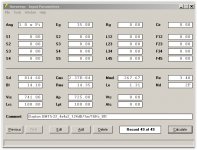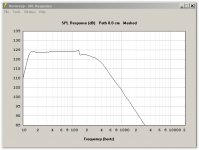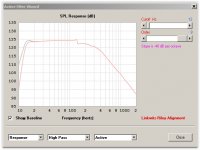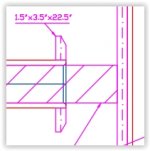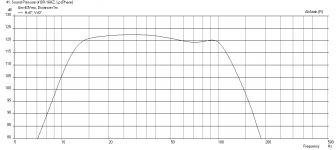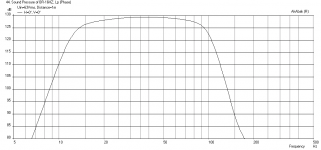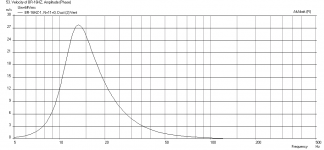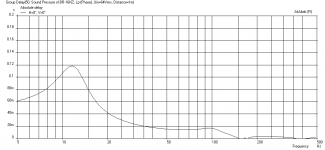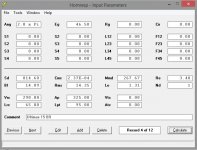Hi Y'all,
It was just pointed out to me by just a guy, that the data-bass.com measurements are 2m groundplane measurements.
Thanks for pointing that out.
A 2m ground plane measurement should be equivalent to an anechoic free field (4xPi) measurement, and should read 6dB lower than the 2xPi measurement at 1m would. That would put the Gjallarhorn's 16Hz SPL @ 124.3dB; and comparing that to the 1xPi we have been using in the simulations puts the Gjallarhorn @ 130.3dB (I think).
It would be nice if Danley's 10m measurement method would become the standard, but that's not going to happen.
Regards,
It was just pointed out to me by just a guy, that the data-bass.com measurements are 2m groundplane measurements.
Thanks for pointing that out.
A 2m ground plane measurement should be equivalent to an anechoic free field (4xPi) measurement, and should read 6dB lower than the 2xPi measurement at 1m would. That would put the Gjallarhorn's 16Hz SPL @ 124.3dB; and comparing that to the 1xPi we have been using in the simulations puts the Gjallarhorn @ 130.3dB (I think).
It would be nice if Danley's 10m measurement method would become the standard, but that's not going to happen.
Regards,
Last edited:
Since the UM18-22 may just be "vaporware", I've been playing with the UM15-22 to get as close to my goals as possible. It winds up at around 124db at 16hz with only 35v which is a much cheaper amp. The box is still 48x48x24 and contains 2 drivers.
Here's how it looks so far.
Steve
Here's how it looks so far.
Steve
Attachments
At the port inlet (inside) I added 2x4s (1.5"x3.5") to help support the edges of the port, there are two port divider braces running the length of the port, and all the way against the rear panel.
Oliver,
I'm trying to understand how you arrived at the entrance flare for the port. Can you point me somewhere?
Thanks,
Steve
Attachments
IF this driver actually becomes available, and IF the T/S parameters are as presently stated (or close) this Dual Driver BR should get to the target of 125dB/1m/15Hz/1xPi. In 2xPi it clocks in @ 122.94dB/16Hz - taking 4dB off for power compression and losses we get 118.94dB/16Hz.
TB46,
What is the volume of the enclosure that you ended up with? From the drawing it appears to be about 750 liters (26.5 cu ft) with a 3.5 in x 22.5 in x 35 in long vent. When I sim'd this, I was only able to get 121 dB at xmax (this is into 1-pi steradian).
Attachments
Post #85
Hi Old Ears,
I look at a drawing like this just the same as an improved scratch paper sketch. Once you have the box in a CAD program you can get all dimensions and details you want. Save a tree, use a CAD program .
.
The exact details will have to be worked out while building the first "prototype". Thanks to e.g. Hornresp we are a lot closer to reality today when we go through the design cycle.
As you pointed out, UM 15-22 should be close to a direct drop in into the box I drew for the UM 18-22.
Regards,
P.S.: Hi Xrk971, the Hornresp Input in Post #79 is after calculating backwards from the drawing. I tried to take all volume losses into account. The duct length is 35.5", the cross-section is (5.5"x22.5")-(5.5"x0.75"x2) (raw opening minus dividers), or 115.5in^2.
Hi Old Ears,
I look at a drawing like this just the same as an improved scratch paper sketch. Once you have the box in a CAD program you can get all dimensions and details you want. Save a tree, use a CAD program
The exact details will have to be worked out while building the first "prototype". Thanks to e.g. Hornresp we are a lot closer to reality today when we go through the design cycle.
As you pointed out, UM 15-22 should be close to a direct drop in into the box I drew for the UM 18-22.
Regards,
P.S.: Hi Xrk971, the Hornresp Input in Post #79 is after calculating backwards from the drawing. I tried to take all volume losses into account. The duct length is 35.5", the cross-section is (5.5"x22.5")-(5.5"x0.75"x2) (raw opening minus dividers), or 115.5in^2.
Attachments
Tb46,
Thanks - I put 684 liters as the volume and adjusted port size to account for brace and realized I did not have 1-pi output setup correctly. Here it is with same dimension as yours and 1-pi with 64 volts rms to get xmax with 12.5 Hz 48dB/oct HPF and 100 Hz 48dB/oct LPF. I get about 127 dB at 16 Hz. There may be an issue with port velocity being 28 m/s that is pretty fast (about 63 mph) which may cause some turbulence noise/chuffing. Also, the group delay at 16 Hz is about 67 ms which is the problem with many BR designs at the deepest extensions. I think 67 ms is substantial and may be unacceptable from a musical timing standpoint?
SPL vs Freq:
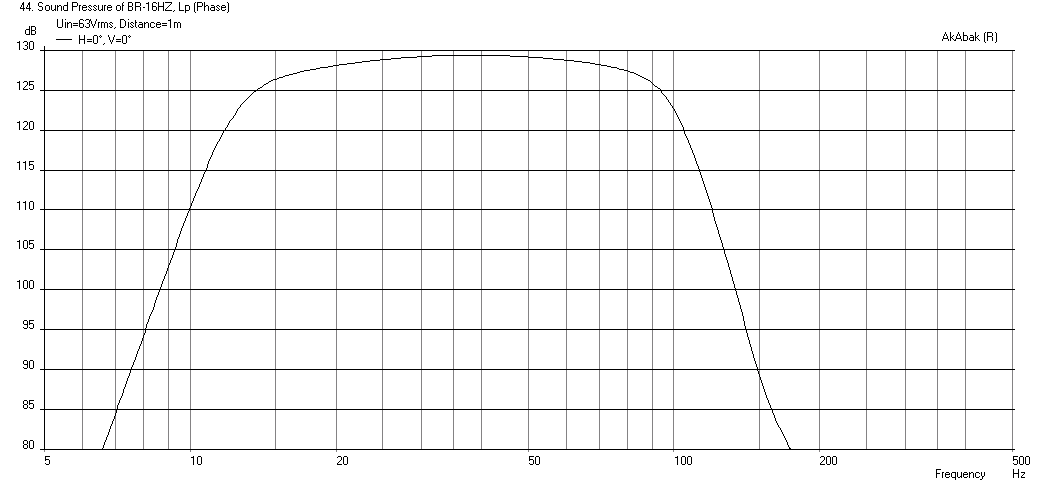
Port Velocity:
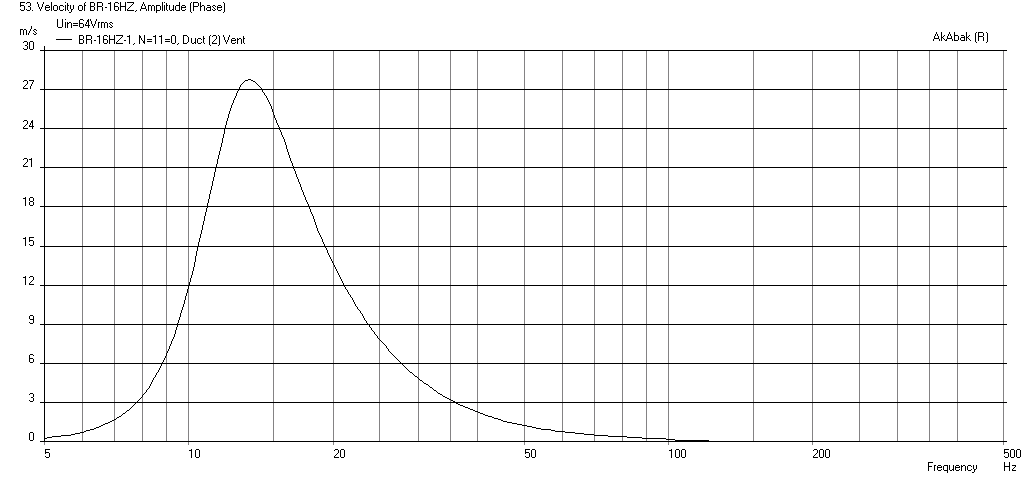
Group Delay:
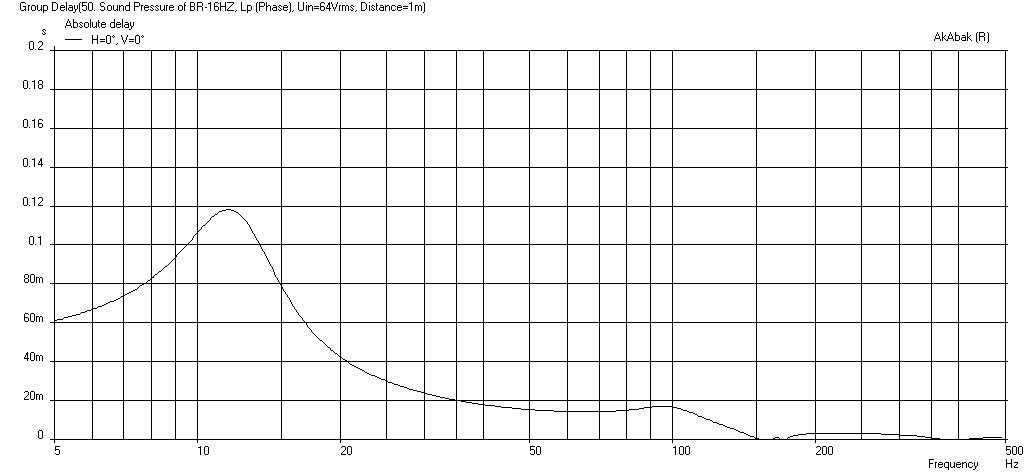
Thanks - I put 684 liters as the volume and adjusted port size to account for brace and realized I did not have 1-pi output setup correctly. Here it is with same dimension as yours and 1-pi with 64 volts rms to get xmax with 12.5 Hz 48dB/oct HPF and 100 Hz 48dB/oct LPF. I get about 127 dB at 16 Hz. There may be an issue with port velocity being 28 m/s that is pretty fast (about 63 mph) which may cause some turbulence noise/chuffing. Also, the group delay at 16 Hz is about 67 ms which is the problem with many BR designs at the deepest extensions. I think 67 ms is substantial and may be unacceptable from a musical timing standpoint?
SPL vs Freq:

Port Velocity:

Group Delay:

Attachments
I think 67 ms is substantial and may be unacceptable from a musical timing standpoint?
Hi xrk971,
Remember that those frequencies are there to replicate a pipe organs lowest notes. Pipe organs inherently have severe delay in some of the pipes due to the mechanical lag in servo valves and air flow.
Now if these were intended to be used for dubstep and electronic music the delay could be a problem.
Steve
In Toronto tonight... loud organ music celebrating 100 yrs on one of our biggest (St. Pauis on Bloor Street, 5-manual Aeolian-Skinner, where I recorded before)... wish there was some way I could record some snippets to see how much 16 Hz is present. That would shed some light on two recent threads in the subwoofer section.
Even if I get permission, not sure how to handle my poor gear (MacBook Pro, iMic, Radio Shack SPL, large shopping bag to hide it all in.... can I record with the cover of the MacBook closed???).
On Halloween, I report to DIYaudio on the fun masquerade organ spectacular. Some organ fans might consider coming to Toronto for such events.
Ben
Even if I get permission, not sure how to handle my poor gear (MacBook Pro, iMic, Radio Shack SPL, large shopping bag to hide it all in.... can I record with the cover of the MacBook closed???).
On Halloween, I report to DIYaudio on the fun masquerade organ spectacular. Some organ fans might consider coming to Toronto for such events.
Ben
Last edited:
Hi xrk971,
Remember that those frequencies are there to replicate a pipe organs lowest notes. Pipe organs inherently have severe delay in some of the pipes due to the mechanical lag in servo valves and air flow.
Now if these were intended to be used for dubstep and electronic music the delay could be a problem.
Steve
Agree on both points. I like front loaded horns and closed cab designs for that exact reason.
jn
Remember that those frequencies are there to replicate a pipe organs lowest notes. Pipe organs inherently have severe delay in some of the pipes due to the mechanical lag in servo valves and air flow.
The additional delay would exacerbate the servo-mechanism delay in a recording. But you are saying that since this is meant to play live music, the delay would actually replicate the inherent delay present in a real servo actuated organ pipe?
Hi xrk971,
I don't think that group delay in the lower subwoofer octave (e.g.: 15-30Hz) has been fully researched yet. I tend to feel that it is not too important (no solid data to support that assumption). I have seen an "audibility threshold" suggested as 1 to 2 cycles of the respective low frequency; at 15Hz that gives you something between 66 and 132 msec.
The problem of driving the box resonance lower to lower the point at which the group delay reaches maximum is that you then raise the displacement of the driver at the upper resonance peak. So it's probably a matter of compromises again.
One thing is for sure, that specifying a range of 15-80Hz, and an SPL of 125db/15Hz/1m/1xPi in a single enclosure within a limited enclosure volume makes for a difficult design challenge. THs don't have the range, FLHs are too big, CB need a lot of amplifier power, the list goes on .....
Just guessing, the room, electronic organ, drive electronics and the rest of the speakers for the extended spectrum will all have a greater influence at what all this is going to sound like.
Regards,
I don't think that group delay in the lower subwoofer octave (e.g.: 15-30Hz) has been fully researched yet. I tend to feel that it is not too important (no solid data to support that assumption). I have seen an "audibility threshold" suggested as 1 to 2 cycles of the respective low frequency; at 15Hz that gives you something between 66 and 132 msec.
The problem of driving the box resonance lower to lower the point at which the group delay reaches maximum is that you then raise the displacement of the driver at the upper resonance peak. So it's probably a matter of compromises again.
One thing is for sure, that specifying a range of 15-80Hz, and an SPL of 125db/15Hz/1m/1xPi in a single enclosure within a limited enclosure volume makes for a difficult design challenge. THs don't have the range, FLHs are too big, CB need a lot of amplifier power, the list goes on .....
Just guessing, the room, electronic organ, drive electronics and the rest of the speakers for the extended spectrum will all have a greater influence at what all this is going to sound like.
Regards,
snip
One thing is for sure, that specifying a range of 15-80Hz, and an SPL of 125db/15Hz/1m/1xPi in a single enclosure within a limited enclosure volume makes for a difficult design challenge. THs don't have the range, FLHs are too big, CB need a lot of amplifier power, the list goes on .....
Right.
The wonderful, large Cassavant organ last night was especially full/loud (as was the subway passsing underneath*). Only a few times in the whole thrillingly loud night did it hit 98dBC (fast, Radio Shack Cosmic Standard Device). Never went above maybe 99dBC.
LOTS of sound last night that felt like maybe 16-22 Hz (which, I discovered just yesterday, is also present on the recordings I made there 20 yrs ago but rarely on my vinyl organ music collection or, I think, on my more recent CDs).
I think enthusiasts play concert-hall acoustic music louder at home than it occurs in concert halls. Different genre, eh.
Ben
*never heard it till many years later, but folks now can hear recordings CBS/Columbia made in New York that have 6th Ave Subway rumblings - great example and great performance, is Wanda Landovska's Goldberg Variations. Possibly recent re-issues have the X-minute interval subway trains filtered away... pity because she plays a very bassy harpsichord made to her spec)
Last edited:
Ben,The wonderful, large Cassavant organ last night was especially full/loud (as was the subway passsing underneath*). Only a few times in the whole thrillingly loud night did it hit 98dBC (fast, Radio Shack Cosmic Standard Device). Never went above maybe 99dBC.
LOTS of sound last night that felt like maybe 16-22 Hz (which, I discovered just yesterday, is also present on the recordings I made there 20 yrs ago but rarely on my vinyl organ music collection or, I think, on my more recent CDs).
A proper sound level meter on "C" scale reads about -6 dB at 20 Hz, and -13 dB at 10 Hz, your RS meter may read even less than that down low, the 16 Hz pipes (and the subway
At 20 Hz, a 5 dB difference sounds twice (or half) as loud.
Art
Ummm, the SVS RS calibration for my model at 20 Hz is "add 7.5 DB," aside from the fact that I've been staring at that plotted correction using REW for 100000 hrs in the last little while.
Now that is a truly unimportant fact to know in tweaking my subs since my ears bear my "house curve" preference, disirregardless of the cheapie gear I use for measurements and the enduring truth or falsity of the readings. Being a scientist, I am compulsive about consistency in measurement technique, whatever quality of gear I use for measurements which often just plain doesn't matter.
Now, sitting in the church, alas I was unable to have a third-octave filter with me in order to disassemble the sound and determine what was in what third-octave band... as I am sure Art does when he tests.
So it is possible that the organ sound (which as Art might know, is a whole lot more broad and more evenly broad-spectrum powered than anything else musical I can recall eyeballing by spectrum) was not perfectly characterized by my old RS SPL meter.
In fact, as Art correctly points out, my readings definitely underestimated the loudness in the church because the extra low notes were not correctly accounted for on those occasions they were present as a material element of the loudness.
Gosh, instead of 98dBC, maybe an instrument correction to 99dBC (or more!) is closer to the truth. And, in the interests of precision, I want everybody to know that "dBC" underestimates "dB" or the power of sound to heat water and lift weight. I hope and pray readers will excuse me.
Ben
Now that is a truly unimportant fact to know in tweaking my subs since my ears bear my "house curve" preference, disirregardless of the cheapie gear I use for measurements and the enduring truth or falsity of the readings. Being a scientist, I am compulsive about consistency in measurement technique, whatever quality of gear I use for measurements which often just plain doesn't matter.
Now, sitting in the church, alas I was unable to have a third-octave filter with me in order to disassemble the sound and determine what was in what third-octave band... as I am sure Art does when he tests.
So it is possible that the organ sound (which as Art might know, is a whole lot more broad and more evenly broad-spectrum powered than anything else musical I can recall eyeballing by spectrum) was not perfectly characterized by my old RS SPL meter.
In fact, as Art correctly points out, my readings definitely underestimated the loudness in the church because the extra low notes were not correctly accounted for on those occasions they were present as a material element of the loudness.
Gosh, instead of 98dBC, maybe an instrument correction to 99dBC (or more!) is closer to the truth. And, in the interests of precision, I want everybody to know that "dBC" underestimates "dB" or the power of sound to heat water and lift weight. I hope and pray readers will excuse me.
Ben
Hi Y'all,
Well, it's the international day of labor, so I took some of my sitting around time to take a stab at a 2D drawing of the Dayton UM 18-22, and at a BR enclosure using Old Ears' outside dimensions.
Looking at it for a little while, I arrived at a more symmetrical layout w/ the port inbetween the drivers, this should also split up, and support the large side panels.
At the port inlet (inside) I added 2x4s (1.5"x3.5") to help support the edges of the port, there are two port divider braces running the length of the port, and all the way against the rear panel.
Additional 2x2 (1.5"x1.5") braces help to support the large panels. The drivers are mounted on a three board thick baffle that is set back to provide room for the diaphragm to move to its forward excursion limit.
From my experience I lean towards panel bracing and cross-bracing over additional wall thickness. If additional wall thickness is desired it may be a good idea to go w/ void-free plywood instead of MDF. MDF adds a lot of weight to a given panel, but its stiffness increase is not as high as that of plywood (which is also lighter); so doubled MDF panels will not raise the panel resonance as much as doubled plywood would; others have suggested using plywood inside, and MDF outside (North Creek?).
The nominal cutout diameter is 17", this needs to be checked on the real thing, as it looks like a smaller cutout circle might work for mounting from the front.
I subtracted all volume losses caused by drivers, port and braces to get the attached Hornresp simulation.
IF this driver actually becomes available, and IF the T/S parameters are as presently stated (or close) this Dual Driver BR should get to the target of 125dB/1m/15Hz/1xPi. In 2xPi it clocks in @ 122.94dB/16Hz - taking 4dB off for power compression and losses we get 118.94dB/16Hz.
That would put it into an exclusive club, even the best systems on data-bass.com do not get higher, the Gjallarhorn comes close @ 118.3dB/16Hz, the DTS-10 LMS-R falls of another 2.3dB. Naturally, these are actual measurements in a 2xPi environment.
Hope somebody gets to build this.
Regards,
Has anyone built this design? The drivers have been out for awhile now and this design seems pretty solid for both the pipe organ purpose and general HT.
Has anyone built this design? The drivers have been out for awhile now and this design seems pretty solid for both the pipe organ purpose and general HT.
I've got a pair of Ultimax 15s in a similar situation, but two cabinets with single drivers tuned somewhere around 16 hz. They offer pretty good output, but honestly at some point in the future, they're going to be in something different...the BR cabs were "Let's just do this for now."
Attachments
- Status
- This old topic is closed. If you want to reopen this topic, contact a moderator using the "Report Post" button.
- Home
- Loudspeakers
- Subwoofers
- Reproducing a 16Hz pipe organ note
